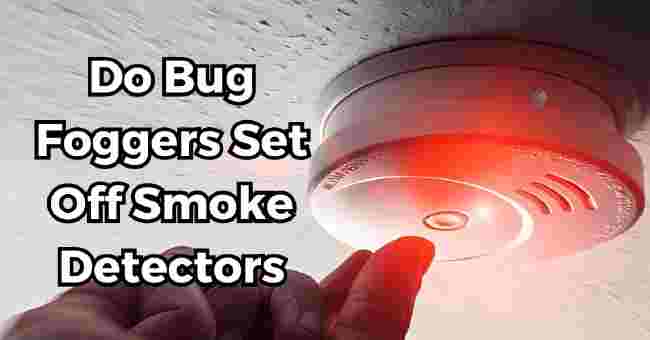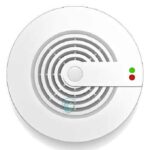Table of Contents
Have you ever found yourself in a predicament where the very tool meant to eliminate unwanted pests from your home turns into a source of anxiety instead?
We’re talking about bug foggers, those trusty aerosol cans that promise to eradicate pesky insects but also raise a lingering concern: will they set off my smoke detectors?
Picture this: you’ve meticulously followed the instructions, evacuated your home, and set the timer on the bug fogger.
As the minutes tick by, you can almost hear the insects surrendering to the insecticide’s wrath.
But just when you’re about to breathe a sigh of relief, a piercing alarm shatters the silence.
Your smoke detector, mistaking the fogger’s cloud for a fire hazard, has decided to make its presence known.
This common scenario highlights the delicate balance between pest control and home safety.
While bug foggers offer a convenient and effective way to eliminate insects, their use can also trigger smoke detectors, leading to unnecessary alarms and even potential harm.
So, the question remains: do bug foggers set off smoke detectors? And if so, what can we do to prevent these unwanted disruptions?
To unravel this mystery, let’s delve into the world of smoke detectors and bug foggers, exploring their workings and potential interactions.
We’ll also uncover preventive measures to ensure a peaceful pest control experience without the unwelcome symphony of smoke alarms.
Understanding Smoke Detectors: Sentinels of Home Safety
Before we assess the potential for bug foggers to activate smoke detectors, it’s crucial to understand the different types of smoke detectors and their underlying principles.
Smoke detectors, the vigilant guardians of our homes, serve as our first line of defense against the dangers of fire.
These devices continuously monitor the air for the presence of smoke particles, alerting us to potential hazards before they escalate into devastating fires.
Types of Smoke Detectors:
Smoke detectors come in two primary types: ionization and photoelectric. Each type utilizes a distinct mechanism to detect smoke, catering to different types of fire hazards.
- Ionization Smoke Detectors:
Ionization smoke detectors operate on the principle of ionization, using a small amount of radioactive material to create a stream of charged particles.
When smoke particles enter the detector, they disrupt this stream, causing an imbalance in the electrical current and triggering the alarm.
Ionization smoke detectors are particularly effective in detecting fast-flaming, fuel-based fires, such as those caused by grease or paper.
- Photoelectric Smoke Detectors:
Photoelectric smoke detectors, on the other hand, employ a beam of light to detect smoke particles.
As smoke enters the detector, it scatters the light beam, causing it to hit a photoelectric sensor.
This interruption in the light beam triggers the alarm.
Photoelectric smoke detectors are more adept at detecting slow-burning, smoldering fires, such as those caused by electrical wiring or upholstery.
Understanding Smoke Detector Sensitivities:
The sensitivity of smoke detectors, their ability to detect minute amounts of smoke, is a critical factor in their effectiveness.
However, this sensitivity can also make them susceptible to false alarms, particularly when exposed to substances that resemble smoke particles.
This is where bug foggers come into play. The fine particles and aerosols released by bug foggers can sometimes mimic smoke, especially for ionization smoke detectors.
These particles, when dispersed in the air, can disrupt the ionization chamber or scatter the light beam, triggering the alarm.
Do Bug Foggers Set Off Smoke Detectors: Unveiling the Secrets of Bug Foggers
To fully comprehend the potential for bug foggers to trigger smoke detectors, it’s essential to understand their composition.
Bug foggers, also known as total release foggers or bug bombs, are aerosol cans that release a fine mist of insecticides into the air.
This mist, designed to eliminate insects throughout the treated area, is composed of various active and inactive ingredients.
Active Ingredients: The Insect-Fighting Arsenal
The active ingredients in bug foggers are the potent substances responsible for killing insects.
These ingredients typically belong to the pyrethroid family, synthetic compounds that mimic natural pyrethrins found in chrysanthemum flowers.
Pyrethroids act as neurotoxins, disrupting the nervous system of insects and leading to their paralysis and death.
Inactive Ingredients: The Supporting Cast
While active ingredients deliver the knockout punch to insects, inactive ingredients play a supporting role.
These inactive ingredients, also known as inert ingredients, serve various purposes, including:
- Propellants: Propellants, such as butane, propane, and isobutane, provide the pressure needed to disperse the active ingredients throughout the treated area. They create the fine mist that allows the insecticide to reach hidden corners and crevices where insects may reside.
- Solubilizers: Solubilizers, like ethanol and petroleum distillates, help dissolve the active ingredients in the propellant, ensuring a uniform and consistent mist. They prevent the active ingredients from separating and settling, ensuring effective insecticide distribution.
- Fragrances: Fragrances, while not essential for pest control, are often added to bug foggers to mask the unpleasant odor of the insecticides. They can also provide a lingering scent that suggests the area has been treated.
- Other Additives: Other additives, such as stabilizers and preservatives, may be present in bug foggers to maintain the product’s stability and extend its shelf life. They help prevent the active ingredients from breaking down or becoming less effective over time.
The Role of Inactive Ingredients in Smoke Detector Activation
While the active ingredients in bug foggers are responsible for killing insects, the inactive ingredients may play a role in smoke detector activation.
The fine particles and aerosols produced by propellants and solubilizers, if sufficiently concentrated, can mimic smoke particles, potentially triggering ionization smoke detectors.
However, it’s important to note that not all bug foggers are equally likely to trigger smoke detectors.
The specific formulation of the fogger, including the type and concentration of inactive ingredients, can influence its potential to cause false alarms.
Additionally, the sensitivity of the smoke detector itself plays a significant role.
Ionization smoke detectors are generally more susceptible to false alarms from bug foggers than photoelectric smoke detectors.
Navigating the Risk of Smoke Detector Activation: A Closer Look
Now that we understand the composition of bug foggers and the workings of smoke detectors, let’s delve into the potential for smoke detector activation.
As we’ve discussed, the fine particles and aerosols released by bug foggers can, in some cases, trigger ionization smoke detectors.
Ionization Smoke Detectors: The More Susceptible Counterpart
Ionization smoke detectors, due to their sensitivity to small particles, are more likely to be activated by bug foggers than photoelectric smoke detectors.
The ionization chamber in these detectors is designed to detect even minute changes in the electrical current caused by smoke particles.
The fine mist from bug foggers, if sufficiently concentrated, can disrupt this delicate balance, triggering the alarm.
Factors Influencing Smoke Detector Activation
Several factors can influence the likelihood of smoke detector activation by bug foggers:
- Bug Fogger Formulation: As mentioned earlier, the specific formulation of the bug fogger, including the type and concentration of inactive ingredients, can affect its potential to trigger smoke detectors. Foggers with higher concentrations of propellants and solubilizers may pose a higher risk.
- Smoke Detector Sensitivity: The sensitivity of the smoke detector itself plays a crucial role. More sensitive smoke detectors are more likely to be activated by bug foggers, even in cases where the fogger’s mist is not particularly dense.
- Environmental Conditions: Environmental conditions, such as air circulation and humidity, can also influence the risk of false alarms. Poor ventilation or high humidity can trap the fogger’s mist, increasing its concentration and making it more likely to trigger the smoke detector.
Photoelectric Smoke Detectors: A Lower Risk
Photoelectric smoke detectors are generally less susceptible to false alarms from bug foggers.
These detectors rely on the detection of light scattering caused by smoke particles.
The fine mist from bug foggers may not scatter light to a sufficient degree to activate the photoelectric sensor, reducing the risk of false alarms.
Ensuring Peace of Mind: Preventive Measures to Avoid Smoke Detector Activation
Now that we’ve explored the potential for smoke detector activation by bug foggers, let’s turn our attention to preventive measures.
By following these simple guidelines, you can minimize the risk of unnecessary alarms and ensure a more peaceful pest control experience.
1. Careful Product Selection:
The choice of bug fogger can significantly impact the likelihood of smoke detector activation.
Look for foggers specifically designed to be less prone to triggering smoke detectors.
These foggers may have lower concentrations of propellants and solubilizers or contain additives that reduce the mist’s particle size.
2. Proper Ventilation:
Adequate ventilation is crucial for dissipating the fogger’s mist and reducing its concentration.
Open windows and doors throughout the treated area to allow fresh air to circulate. If possible, turn on fans to further promote air movement.
3. Covering Smoke Detectors:
Temporarily covering smoke detectors with plastic bags or sheets can help prevent them from being activated by the fogger’s mist.
Ensure the coverings are secure and don’t obstruct the smoke detector’s vents.
4. Evacuating the Premises:
Evacuating the premises during bug fogger use is essential for safety reasons and can also help reduce the risk of smoke detector activation.
As the fogger releases its mist, the concentration of particles may be higher in occupied areas, increasing the likelihood of triggering ionization smoke detectors.
5. Post-Application Precautions:
Upon returning to the treated area, allow sufficient time for the fogger’s mist to dissipate before uncovering smoke detectors and turning on fans.
This will help minimize the risk of false alarms.
6. Regular Smoke Detector Maintenance:
Regularly test and maintain your smoke detectors to ensure they are functioning properly.
Replace batteries as needed and clean the detectors to remove dust and debris that could interfere with their sensitivity.
Venturing Beyond Bug Foggers: Alternative Pest Control Methods
While bug foggers offer a convenient and effective way to eliminate insects, they also carry the potential for smoke detector activation and other concerns.
Fortunately, a variety of alternative pest control methods exist that provide effective insect control without the risk of false alarms or potential health hazards.
1. Traps and Baits:
Traps and baits are targeted solutions that attract and capture specific pests without exposing the entire home to insecticides.
Sticky traps, for instance, are effective against crawling insects like cockroaches and ants, while bait stations lure and eliminate pests like cockroaches, rodents, and silverfish.
2. Natural Repellents:
Natural repellents, such as essential oils and botanical extracts, can deter pests without the use of harsh chemicals.
Essential oils like peppermint, lavender, and citronella can be diffused or sprayed around entry points to repel insects.
Botanical extracts like neem oil and pyrethrum can be applied to plants or surfaces to discourage pests.
3. Physical Barriers:
Sealing cracks and crevices, repairing screens, and installing weather stripping can prevent pests from entering your home in the first place.
Additionally, using door sweeps and caulk can seal gaps around doors and windows, further reducing entry points.
4. Environmental Modifications:
Maintaining a clean and clutter-free environment can make your home less attractive to pests.
Regularly dispose of food scraps, store food in airtight containers, and clean up spills promptly. Reduce moisture by addressing leaks and using dehumidifiers in damp areas.
5. Professional Pest Control Services:
For severe pest infestations or when DIY methods prove ineffective, professional pest control services offer expert assistance.
Trained professionals can identify the type of pest, assess the infestation’s extent, and recommend the most appropriate treatment plan.
They may employ a combination of methods, including targeted insecticides, traps, and exclusion techniques, to effectively eliminate the pest problem.
FAQs
How Long Should I Wait After Using A Bug Fogger To Turn On Smoke Detectors?
The recommended wait time after using a bug fogger before turning on smoke detectors varies depending on the specific product and the size of the treated area.
Generally, manufacturers recommend waiting at least 2-4 hours, allowing the fogger’s mist to dissipate adequately.
However, it’s always advisable to err on the side of caution and wait longer if possible.
What Should I Do If My Smoke Detector Goes Off During Bug Fogger Use?
If your smoke detector goes off during bug fogger use, the first step is to evacuate the premises immediately.
Once safely outside, open windows and doors to ventilate the area and allow the fogger’s mist to disperse.
Do not re-enter the premises until the smoke detector has stopped alarming and the mist has dissipated.
Are There Bug Foggers Specifically Designed Not To Trigger Smoke Detectors?
Yes, some bug foggers are specifically formulated to be less prone to triggering smoke detectors.
These foggers may contain lower concentrations of propellants and solubilizers or may include additives that reduce the mist’s particle size.
Look for products labeled as “smoke detector-friendly” or consult with a pest control professional for recommendations.
Can I Use Bug Foggers If I Have Photoelectric Smoke Detectors?
While photoelectric smoke detectors are generally less susceptible to false alarms from bug foggers, it’s still advisable to take precautions.
Follow the product’s instructions carefully, ventilate the area thoroughly, and consider covering the smoke detectors temporarily to minimize the risk of activation.
What Are Some Additional Tips For Preventing Smoke Detector Activation During Bug Fogger Use?
In addition to the preventive measures mentioned earlier, here are some additional tips to minimize the risk of false alarms:
- Avoid using bug foggers in areas with high humidity or poor ventilation.
- Place bug foggers in open areas away from furniture, appliances, and walls to ensure the mist disperses evenly.
- Use the recommended amount of fogger as directed on the product label. Excessive use can increase the risk of smoke detector activation.
As we bring our journey into the world of bug foggers and smoke detectors to a close, let’s recap the key takeaways that will empower you to make informed decisions about pest control and home safety.
Understanding the Risks:
We’ve delved into the workings of smoke detectors and the composition of bug foggers, uncovering the potential for smoke detector activation.
While bug foggers offer effective pest control, the fine particles and aerosols they release can trigger ionization smoke detectors.
Taking Preventive Measures:
We’ve explored practical measures to minimize the risk of false alarms during bug fogger use.
Careful product selection, proper ventilation, and covering smoke detectors can significantly reduce the likelihood of unwanted alarms.
Exploring Alternative Methods:
We’ve ventured beyond bug foggers, discovering a range of alternative pest control methods.
Traps, baits, natural repellents, physical barriers, and environmental modifications offer targeted and non-chemical solutions to pest problems.
Prioritizing Safety Always:
Throughout our exploration, we’ve emphasized the importance of prioritizing home safety.
Smoke detectors are our sentinels against fire hazards, and any interference with their function can have serious consequences.
Conclusion
Now that we’ve explored, bug foggers can potentially set off smoke detectors, especially ionization types.
To prevent unwanted alarms, carefully select foggers, ventilate thoroughly, and cover detectors.
Remember to wait before reactivating detectors. Alternatively, consider traps, repellents or professional services.
Prioritize safety – smoke detectors protect our homes. Moving forward, read instructions, minimize particle concentration, and explore safer options.
With care, you can eliminate pests without compromising home safety.





Pingback: Can Cigarette Smoke Set Off A Smoke Detector: Let's Clear the Air -